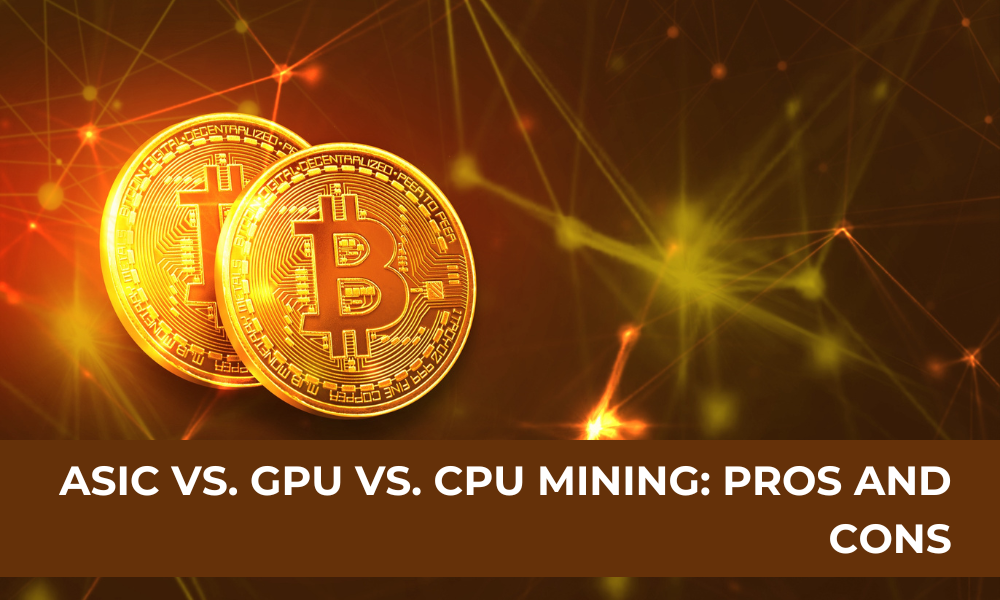In the present day, one must make the right choices in hardware for crypto mining: it lends itself not simply to profitability but also to longevity, calls for engaging different forms, namely ASIC, GPU, and CPU mining—all promising profits but with their own merits and demerits. It would rely more on the individual's mining goal, financial plan, electricity access, and which cryptocurrency would want to mine.
What Is ASIC Mining?
An ASIC or application-specific integrated circuit is an exclusive device dedicated to the work of one specific algorithm, usually for mining coins such as bitcoins. ASICs provide very high hash rate output but relatively low energy consumption with respect to performance. Bitmain and Antminer are two giant players in the ASIC market; these machines work great for proof-of-work cryptocurrencies such as BTC and Litecoin.
What Is GPU Mining?
Mining through GPPUs depends on graphics processing units used mainly in gaming and workstation PCs. These graphics are actually more flexible than ASICs. Miners can switch between algorithms to mine Ethereum Classic, Ravencoin, or Zcash. While GPUs generally have a lower hash rate than ASICs, the flexibility and cheaper pricing make them a favorite among hobbyist miners.
What Is CPU Mining?
Computer central processing unit mining is known as CPU mining. It is the original way to mine Bitcoins. Currently, it is called obsolete, especially for the likes of Bitcoins, as there is little hashrate efficiency. However, CPU mining is still a technique that finds use in small niches, such as mining certain privacy coins like Monero (XMR) or in experimental proof-of-work systems.
Performance Comparison: ASIC vs. GPU vs. CPU
Hash Rate Capabilities
ASICs deliver unmatched hashrate, making them ideal as the best bitcoin miner for high-volume crypto mining operations. GPUs offer decent performance, while CPUs are the slowest, often unable to compete in modern bitcoin mining or other high-difficulty cryptocurrency mining algorithms.
Power Consumption and Efficiency
ASICs are designed for efficiency and generally consume less electricity per hash calculated. Depending on the model, GPUs can be fairly efficient to power-hungry. CPUs typically consume the least amount of electricity, but with their poor hash output, they are inefficient for anything other than extremely low-difficulty coins.
Heat Generation and Noise Levels
ASIC miners usually produce a lot of heat; thus, they must be coupled with advanced cooling solutions. They are also very noisy; hence, they do not fit home applications. GPUs generate less noise and heat, although they also require good ventilation. CPUs generate very little heat and noise, making them good candidates for passive or stealth mining.
Cost Considerations and ROI
Initial Investment Costs
The cost of an ASIC miner ranges from a few hundred bucks to even several thousand dollars, depending on the mining machine model. The price range for a single GPU ranges from $200 to $1500. The cheapest is a CPU, as they are just standard components.
Maintenance and Longevity
ASICs are fixed in terms of purpose and not upgradable. Once obsolete or the algorithm changes, the miners are discarded. GPUs have longer lives since they can be altered or upgraded. While CPUs are cheap, they get exhausted comparatively early because of continuous crypto mining.
Resale Value
Resale values are generally better for GPUs because of demand from gamers and professionals. ASICs depreciate faster. CPUs seldom have resale values, especially after mining.
Mining Flexibility and Coin Compatibility
Supported Algorithms and Coins
ASICs are made for one set of algorithms and are thus only able to mine for coins like BTC, Bitcoin Cash, or Dash. GPUs are capable of handling many cryptocurrency tokens and supporting algorithms such as Ethash, KawPow, and Equihash. CPUs are mainly used to mine coins like Monero, which relies on the RandomX algorithm.
Use Cases for Each Hardware Type
ASICs are best suited for bitcoin miners operating in mining farms or pools with cheap power. GPUs are apt for miners planning to switch actively between coins and algorithms to profit more. CPUs are meant for decentralized mining projects, research, or entry-level experiments.
Pros and Cons Summary
Pros and Cons of ASIC Mining
Pros
- Extremely high hashrate.
- Best efficiency and power ratio.
- High bitcoin mining profit potential.
Cons
- Expensive upfront cost
- No flexibility in algorithms
- Noisy and heat-intensive
Pros and Cons of GPU Mining
Pros
- Algorithm and coin versatility.
- Good resale value.
- Easier to maintain and upgrade.
Cons
- Moderate power usage.
- Requires multiple units for decent performance.
- Not as efficient as ASICs for bitcoin miners.
Pros and Cons of CPU Mining
Pros
- Cheapest to start.
- Low power usage.
- Ideal for privacy coins.
Cons
- Very low hashrate.
- Obsolete for most coins.
- Poor profitability
Which Hardware Is Right for You?
Best for Beginners
For its flexibility and lower risk, GPU mining is probably the easiest way for beginners. These users could also use CPUs for work in areas that stand alone without money investments.
Best for Advanced Miners
ASICs usually take the cake due to profitability and concerns about bitcoin mining. These users, however, will go through the more technical setup of the machines but with much better output.
Best for Experimental and Altcoin Mining
For altcoin mining, especially for newly launched projects or mostly ignored tokens, GPUs and CPUs have no rival.
Final Verdict
Ultimately, the right choice depends on your mining strategy. If you're focused on maximizing ROI and can manage electricity and noise, ASICs are the way to go. If you prefer flexibility and want to engage in altcoin or Ethereum-like mining, a solid GPU rig is the best option. CPU mining is more for tech-savvy users experimenting in niche areas.
Whichever route you take, make sure to calculate your expected earnings using a crypto mining calculator before making any investment. Comparing different setups with tools like a coin calculator will ensure your approach is informed, profitable, and sustainable in the long term.
